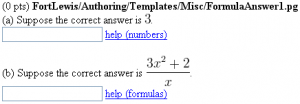Difference between revisions of "FormulaAnswer1"
Jump to navigation
Jump to search
Paultpearson (talk | contribs) (Add link to PGML version in OPL) |
|||
| (11 intermediate revisions by 3 users not shown) | |||
| Line 1: | Line 1: | ||
| − | <h2>Answer is a Number or a Formula</h2> |
+ | <h2>Answer is a Number or a Formula - [https://testcourses.webwork.maa.org/webwork2/Problem_Authoring_Techniques/T-PP-misc/1 Try it out]</h2> |
| − | <p style="background-color:#eeeeee;border:black solid 1px;padding:3px;"> |
||
| + | [[File:FormulaAnswer1.png|300px|thumb|right|Click to enlarge]] |
||
| + | <p style="background-color:#f9f9f9;border:black solid 1px;padding:3px;"> |
||
This PG code shows how to write a question whose answer is a number or a formula. |
This PG code shows how to write a question whose answer is a number or a formula. |
||
| − | <ul> |
||
| − | <li>Download file: [[File:FormulaAnswer1.txt]] (change the file extension from txt to pg when you save it)</li> |
||
| − | <li>File location in NPL: <code>NationalProblemLibrary/FortLewis/Authoring/Templates/Misc/FormulaAnswer1.pg</code></li> |
||
| − | </ul> |
||
</p> |
</p> |
||
| + | * File location in OPL: [https://github.com/openwebwork/webwork-open-problem-library/blob/master/OpenProblemLibrary/FortLewis/Authoring/Templates/Misc/FormulaAnswer1.pg FortLewis/Authoring/Templates/Misc/FormulaAnswer1.pg] |
||
| + | * PGML location in OPL: [https://github.com/openwebwork/webwork-open-problem-library/blob/master/OpenProblemLibrary/FortLewis/Authoring/Templates/Misc/FormulaAnswer1_PGML.pg FortLewis/Authoring/Templates/Misc/FormulaAnswer1_PGML.pg] |
||
| + | <br clear="all" /> |
||
<p style="text-align:center;"> |
<p style="text-align:center;"> |
||
[[SubjectAreaTemplates|Templates by Subject Area]] |
[[SubjectAreaTemplates|Templates by Subject Area]] |
||
| Line 70: | Line 70: | ||
$answer1 = Compute("$a"); |
$answer1 = Compute("$a"); |
||
| − | $answer2 = Compute("$a x^($b) + $b"); |
+ | $answer2 = Compute("$a x^($b) + $b")->reduce(); |
</pre> |
</pre> |
||
</td> |
</td> |
||
| Line 153: | Line 153: | ||
[[Category:Top]] |
[[Category:Top]] |
||
| − | [[Category: |
+ | [[Category:Sample Problems]] |
| + | [[Category:Subject Area Templates]] |
||
Revision as of 21:12, 7 June 2015
Answer is a Number or a Formula - Try it out
This PG code shows how to write a question whose answer is a number or a formula.
- File location in OPL: FortLewis/Authoring/Templates/Misc/FormulaAnswer1.pg
- PGML location in OPL: FortLewis/Authoring/Templates/Misc/FormulaAnswer1_PGML.pg
| PG problem file | Explanation |
|---|---|
|
Problem tagging: |
|
DOCUMENT(); loadMacros( "PGstandard.pl", "MathObjects.pl", "AnswerFormatHelp.pl", ); TEXT(beginproblem()); |
Initialization: |
Context("Numeric");
$a = non_zero_random(-9,9,1);
do { $b = random(2,9,1); } until ( $b != $a );
$answer1 = Compute("$a");
$answer2 = Compute("$a x^($b) + $b")->reduce();
|
Setup:
We use |
Context()->texStrings;
BEGIN_TEXT
Enter \( $answer1 \):
\{ ans_rule(20) \}
\{ AnswerFormatHelp("numbers") \}
$BR
$BR
Enter \( $answer2 \):
\{ ans_rule(20) \}
\{ AnswerFormatHelp("formulas") \}
END_TEXT
Context()->normalStrings;
|
Main Text: |
$showPartialCorrectAnswers = 1; ANS( $answer1->cmp() ); ANS( $answer2->cmp() ); |
Answer Evaluation: |
Context()->texStrings;
BEGIN_SOLUTION
${PAR}SOLUTION:${PAR}
Solution explanation goes here.
END_SOLUTION
Context()->normalStrings;
COMMENT('MathObject version.');
ENDDOCUMENT();
|
Solution: |
